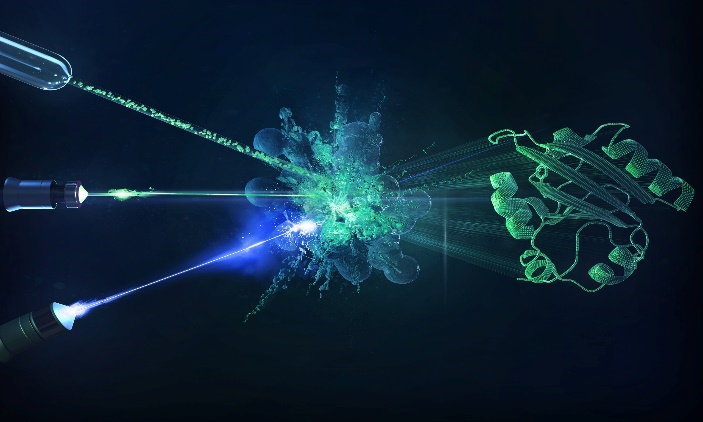UWM Physicist and Graduate Students Highlight Research Work Utilizing Ultrafast X-ray Laser
A recent paper in Nature Methods reports on experiments led by UWM Physics Professor Marius Schmidt at the EuXFEL (the European XFEL), currently the largest X-ray free-electron laser in the world. The experiment focused on time-resolved serial femtosecond crystallography, and showcased the astonishing abilities of the instrument, which is specifically designed to help scientists study biomolecules and individual particles.
The laser (facility), located in Hamburg, Germany, is simply astounding in scope and size. At a cost of more than $1.5 billion, and measuring 3.4 km in length, the machine generates extremely intense X-ray flashes, produced in underground tunnels, which allow scientists from around the world to map atomic details of viruses, film chemical reactions, and even for better understanding the internal makings of planets. Powered at megahertz rates, the X-ray flashes repeat a million times per second, with each flash lasting about 40 femtoseconds and containing enormous amounts of X-ray photons, all of which allow for diffraction experiments from tiny, sub-micrometer crystals to be conducted.
For Dr. Schmidt and his team, the main objective of the experiment was to utilize this equipment to produce a “molecular movie” of the movement of proteins on extremely short time scales.
UWM physics graduate student Suraj Pandey, who was the first author for the study, built on his previous participation in beamtimes at the LCLS (Linac Coherent Light Source in Menlo Park, CA) and at SACLA (the Spring -8 Angstroem Compact X-ray LAser in Harima Science City, Japan). He was the first person to discover a signal in the experimental data obtained from the EuXFEL. In Dr. Schmidt’s lab at UWM and working with Ishwor Poudyal, a fellow UWM Physics graduate student, Suraj also produced the material required for use in the experiment at the EuXFEL – 3 grams of photoactive yellow protein (PYP). Given that similar recombinant protein currently costs $500 for 1 mg, the amount produced for this experiment equated to approximately $1.5 M.
The challenge was to synchronize optical laser pulses with the X-ray pulses at MHz rates. As the reaction is serially started, from scratch, in a never-ending stream of new microcrystals, the pulse sequences must be precisely adjusted to always probe the reaction at the same time-delay; otherwise, time-scales are mixed and the reaction cannot be followed. As a result, the group obtained distinct 3D electron density maps with atomic spatial resolution that show images of shifting electron density clouds as a direct consequence of the reaction on the picosecond time scale. Based on the success of the experiment, it should be possible to collect a time-resolved crystallographic dataset within about 10 minutes at the EuXFEL. Therefore, in a 12-hour shift, hundreds of data sets can be collected, all of which makes the recording of “molecular movies” with closely spaced time-frames possible.

Illustration by European XFEL / Blue Clay Studios
Professor Schmidt and his graduate students at UWM are grateful for the collaboration of colleagues from Arizona State University, the LCLS, the Center for Free Electron Laser Science (CFEL) in Hamburg and the beamline scientists at EuXFEL. Further, this research would not have been possible without funding support from the NSF BioXFEL Science and Technology Center, and the UWM group as part of that Center which includes Distinguished Professor Abbas Ourmazd, Associate Professor Peter Schwander, and former postdoc Dr. Christopher Kupitz.
See also the article by Laura Otto, from the UWM Report . . .